1996 CHEVROLET S10 wheel
[x] Cancel search: wheelPage 223 of 375
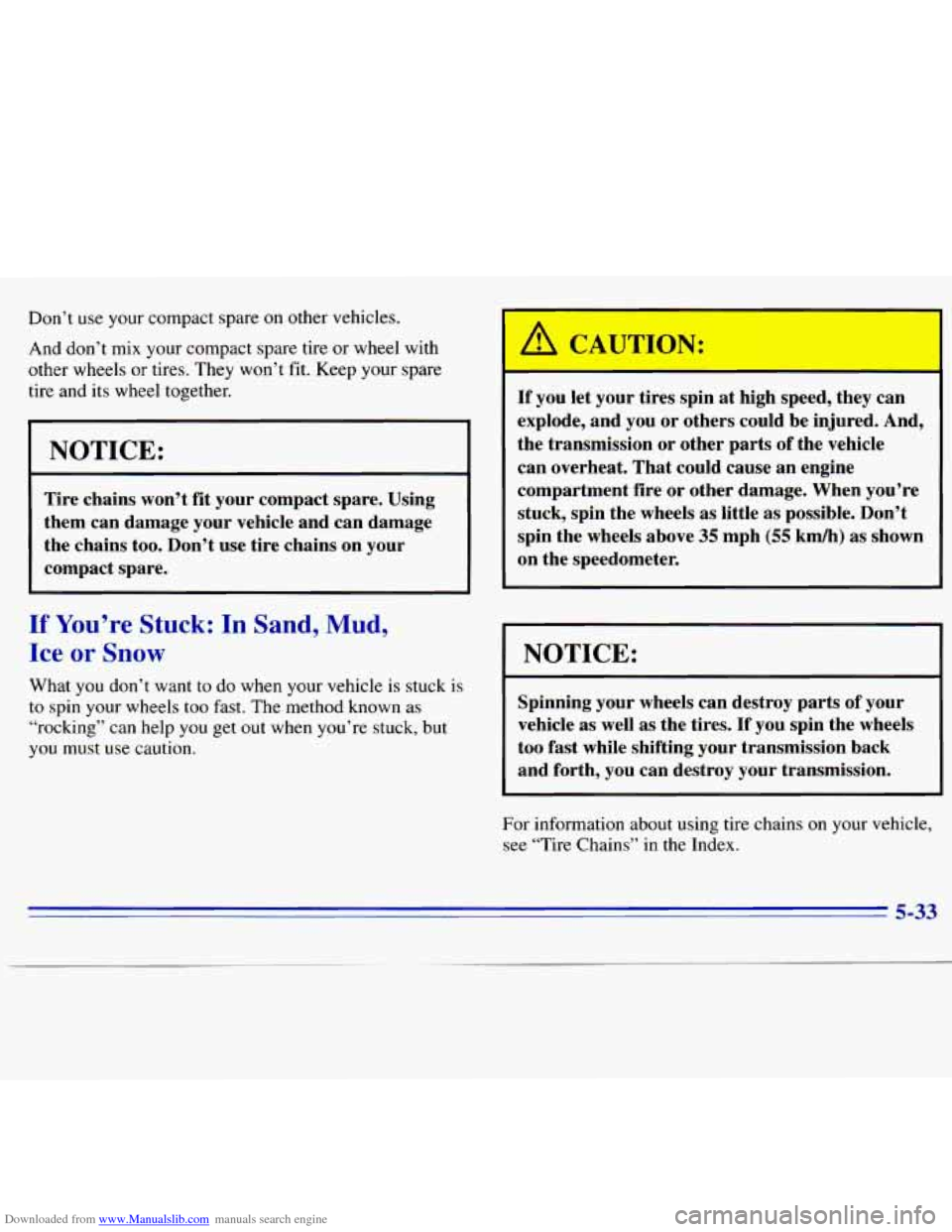
Downloaded from www.Manualslib.com manuals search engine Don’t use your compact spare on other vehicles.
And don’t mix your compact spare tire or wheel with
other wheels or tires. They won’t fit. Keep your spare
tire and its wheel together.
I NOTICE:
Tire chains won’t fit your compact spare. Using
them can damage your vehicle and can damage
the chains too. Don’t use tire chains on your
compact spare.
If You’re Stuck: In Sand, Mud,
Ice or Snow
What you don’t want to do when your vehicle is stuck is
to spin your wheels too fast. The method known as
“rocking” can help you get out when you’re stuck, but
you must
use caution.
I If you let your tires spin at high speed, they can
explode, and you or others could be injured. And,
the transmission or other parts
of the vehicle
can overheat. That could cause an engine
compartment fire or other damage. When you’re stuck,
spin the wheels as little as possible. Don’t
spin the wheels above
35 mph (55 kmh) as shown
on the speedometer.
I
I NOTICE:
Spinning your wheels can destroy parts of your
vehicle as well as the tires.
If you spin the wheels
too
fast while shifting your transmission back
and forth, you can destroy your transmission.
For information about using tire chains on your vehicle,
see “Tire Chains” in the Index.
5-33
Page 224 of 375
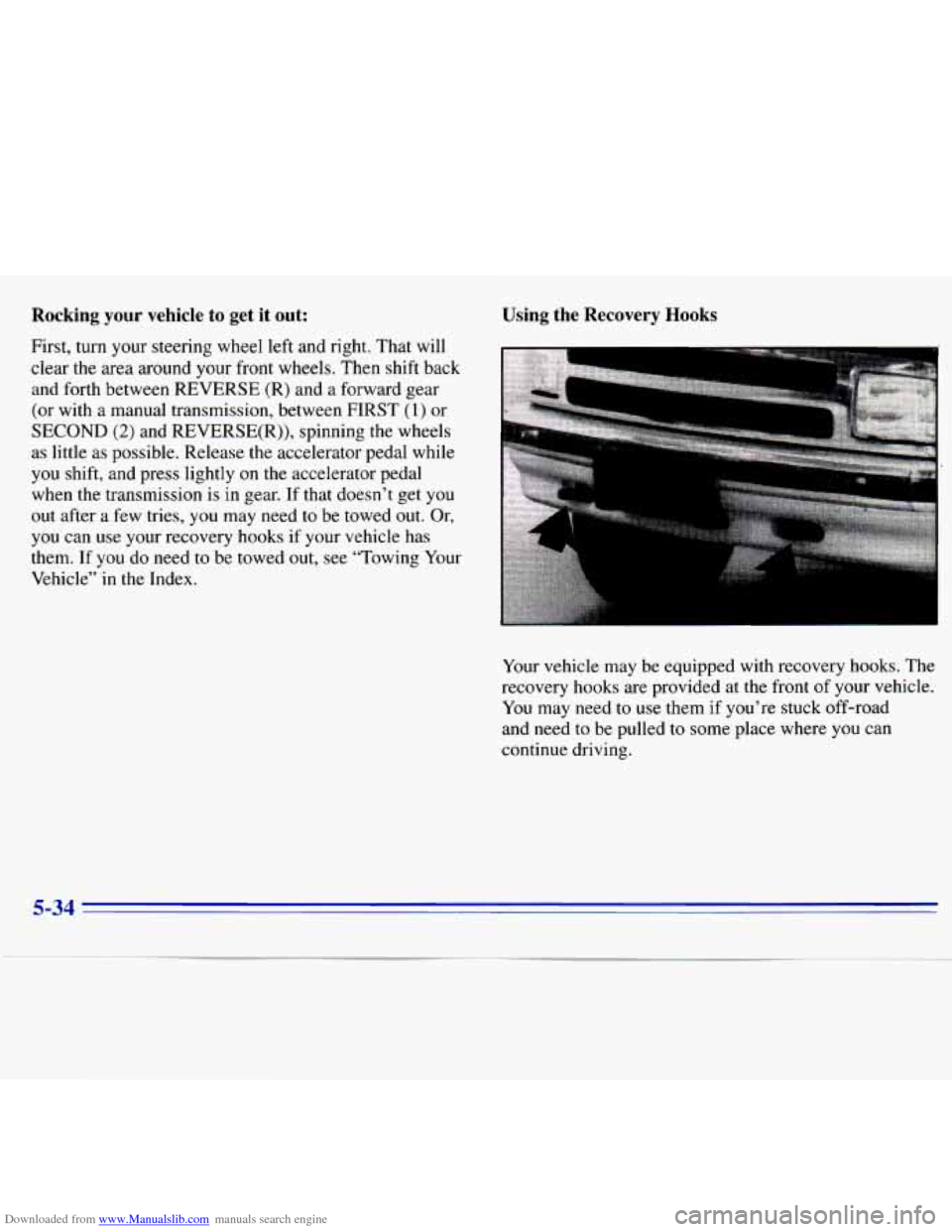
Downloaded from www.Manualslib.com manuals search engine Rocking your vehicle to get it out: Using the Recovery Hooks
First, turn your steering wheel left and right. That will
clear
the area around your front wheels. Then shift back
and forth between REVERSE
(R) and a forward gear
(or with a manual transmission, between FIRST
(1) or
SECOND
(2) and REVERSE(R)), spinning the wheels
as little
as possible. Release the accelerator pedal while
you shift, and press lightly
on the accelerator pedal
when the transmission is in gear. If that doesn’t get you
out after
a few tries, you may need to be towed out. Or,
you can use your recovery hooks if your vehicle has
them.
If you do need to be towed out, see “Towing Your
Vehicle” in
the Index.
Your vehicle may be equipped with recovery hooks. The
recovery hooks are provided at the front
of your vehicle.
You may need
to use them if you’re stuck off-road
and need
to be pulled to some place where you can
continue driving.
5-34
Page 240 of 375
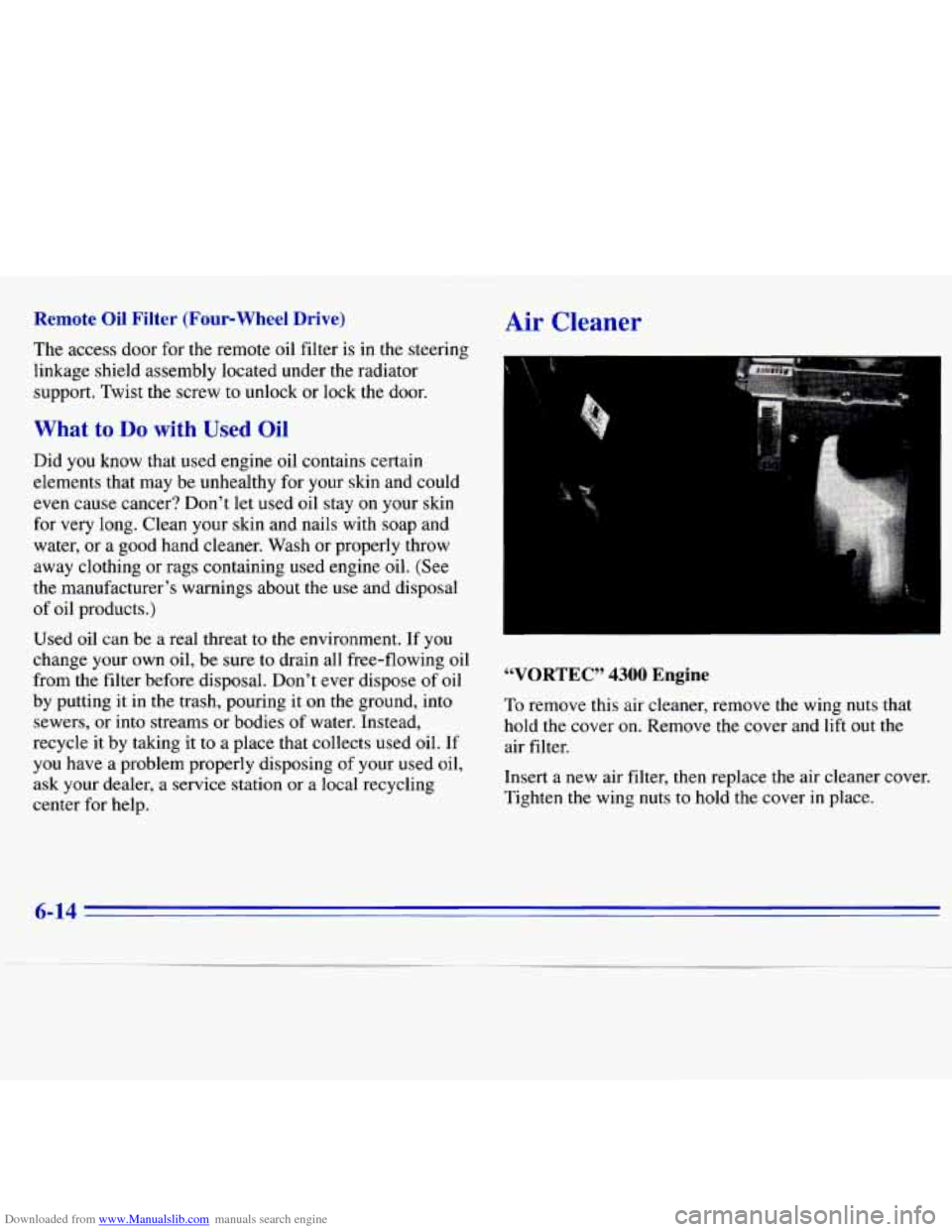
Downloaded from www.Manualslib.com manuals search engine Remote Oil Filter (Four-wheel Drive)
The access door for the remote oil filter is in the steering
linkage shield assembly located under the radiator
support. Twist the screw to unlock or lock the door.
What to Do with Used Oil
Did you know that used engine oil contains certain
elements that may be unhealthy for your skin and could
even cause cancer? Don’t let used oil stay
on your skin
for very long. Clean your skin and nails with soap and
water, or a good hand cleaner. Wash or properly throw
away clothing or rags containing used engine oil. (See
the manufacturer’s warnings about the use and disposal
of oil products.)
Used oil can be a real threat
to the environment. If you
change your own oil, be sure
to drain all free-flowing oil
from the filter before disposal. Don’t ever dispose
of oil
by putting it in the trash, pouring it on the ground, into
sewers, or into streams
or bodies of water. Instead,
recycle it by taking it to a place that collects used
oil. If
you have a problem properly disposing
of your used oil,
ask your dealer, a service station or a local recycling
center for help.
Air Cleaner
“VORTEC” 4300 Engine
To remove this air cleaner, remove the wing nuts that
hold the cover
on. Remove the cover and lift out the
air filter.
Insert a new air filter, then replace the air cleaner cover.
Tighten the wing nuts to hold the cover
in place.
6-14
Page 248 of 375
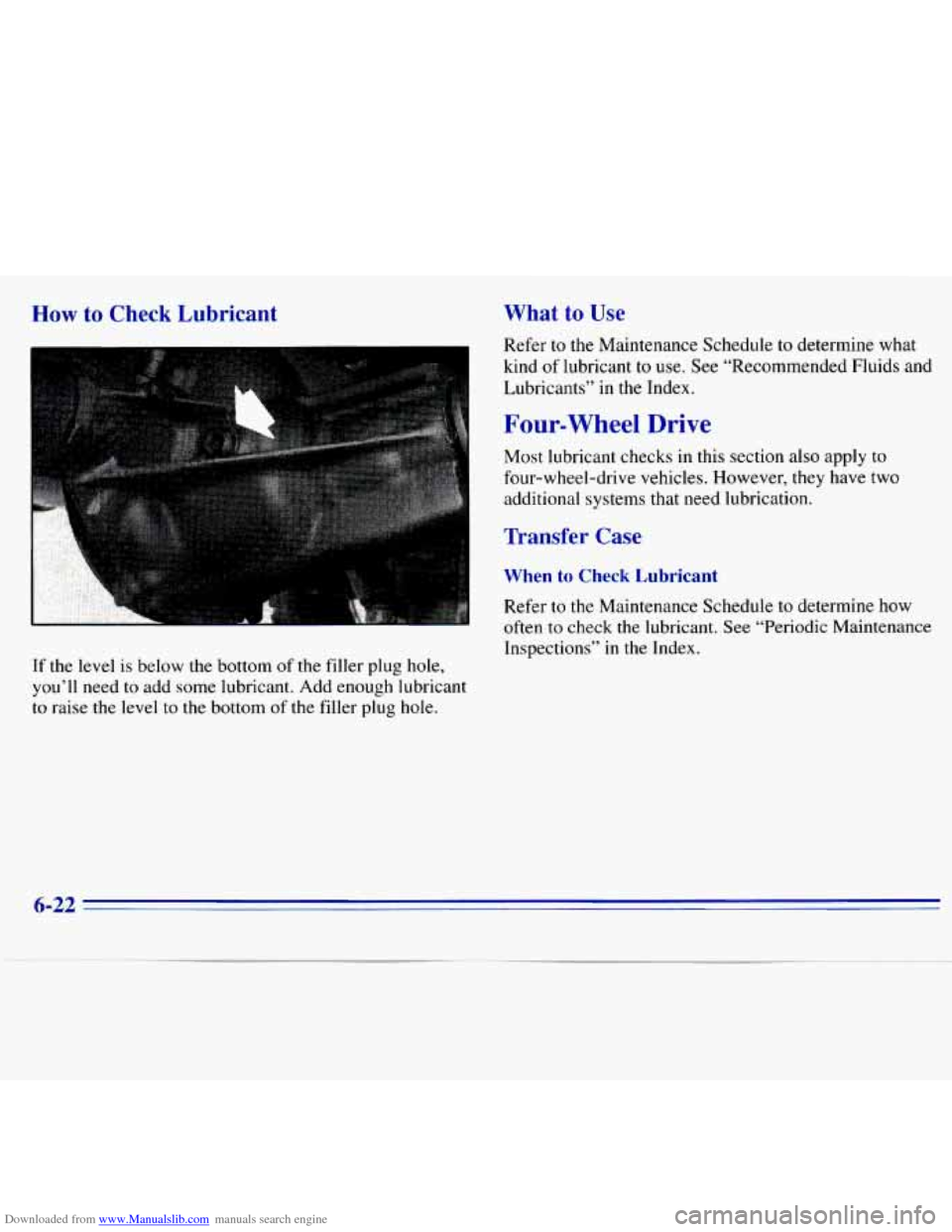
Downloaded from www.Manualslib.com manuals search engine How to Check Lubricant
If the level is below the bottom of the filler plug hole,
you’ll need to add some lubricant. Add enough lubricant
to raise the level to the bottom of the filler plug hole.
What to Use
Refer to the Maintenance Schedule to determine what
kind
of lubricant to use. See “Recommended Fluids and
Lubricants” in the Index.
Four-wheel Drive
Most lubricant checks in this section also apply to
four-wheel-drive vehicles. However, they have two
additional systems that need lubrication.
Transfer Case
When to Check Lubricant
Refer to the Maintenance Schedule to determine how
often
to check the lubricant. See “Periodic Maintenance
Inspections”
in the Index.
6-22
Page 260 of 375
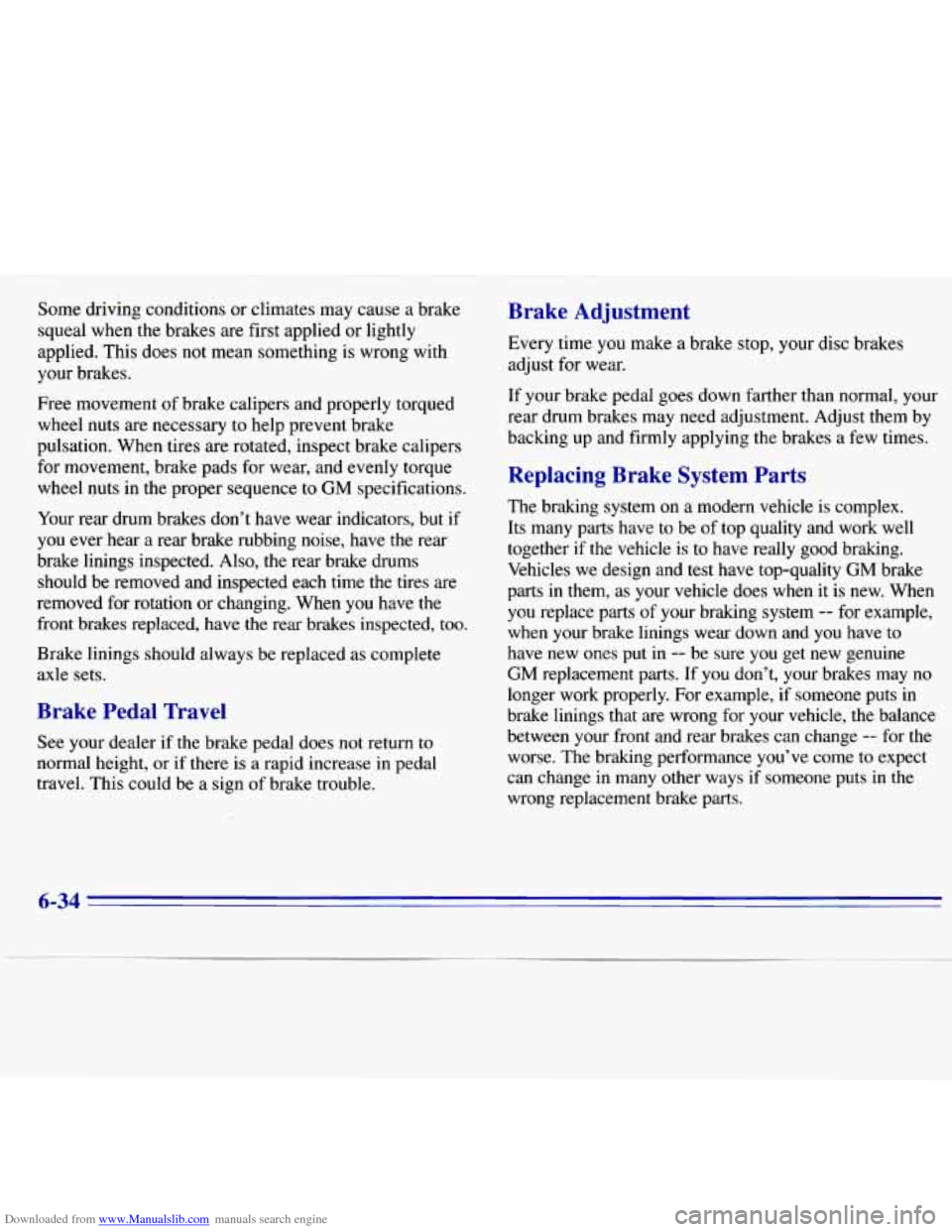
Downloaded from www.Manualslib.com manuals search engine Some driving conditions or climates may cause a brake
squeal when the brakes are first applied or lightly
applied. This does not mean something is wrong
with
your brakes.
Free movement of brake calipers and properly torqued
wheel nuts are necessary to help prevent brake
pulsation. When tires are rotated, inspect brake calipers
for movement, brake pads
for wear, and evenly torque
wheel nuts in the proper sequence to
GM specifications.
Your rear drum brakes don’t have wear indicators, but if
you ever hear
a rear brake rubbing noise, have the rear
brake linings inspected. Also, the rear brake drums
should be removed and inspected each time the tires are
removed for rotation or changing. When
you have the
front brakes replaced, have the rear brakes inspected, too.
Brake linings should always be replaced as complete
axle sets.
Brake Pedal Travel
See your dealer if the brake pedal does not return to
normal height, or if there is a rapid increase in pedal
travel. This could be
a sign of brake trouble.
Brake Adjustment
Every time you make a brake stop, your disc brakes
adjust for wear.
If your brake pedal goes down farther than normal, your
rear drum brakes may need adjustment. Adjust them by
backing
up and firmly applying the brakes a few times.
Replacing Brake System Parts
The braking system on a modern vehicle is complex.
Its many parts have to be of top quality
and work well
together if the vehicle is to have really good braking.
Vehicles we design and test have top-quality
GM brake
parts
in them, as your vehicle does when it is new. When
you replace parts of your braking system
-- for example,
when your brake linings wear down and you have to
have new ones put in
-- be sure you get new genuine
GM replacement parts. If you don’t, your brakes may no
longer work properly. For example,
if someone puts in
brake linings that are wrong for your vehicle, the balance
between your front and rear brakes can change
-- for the
worse. The braking performance you’ve come
to expect
can change
in many other ways if someone puts in the
wrong replacement brake parts.
6-34
Page 272 of 375
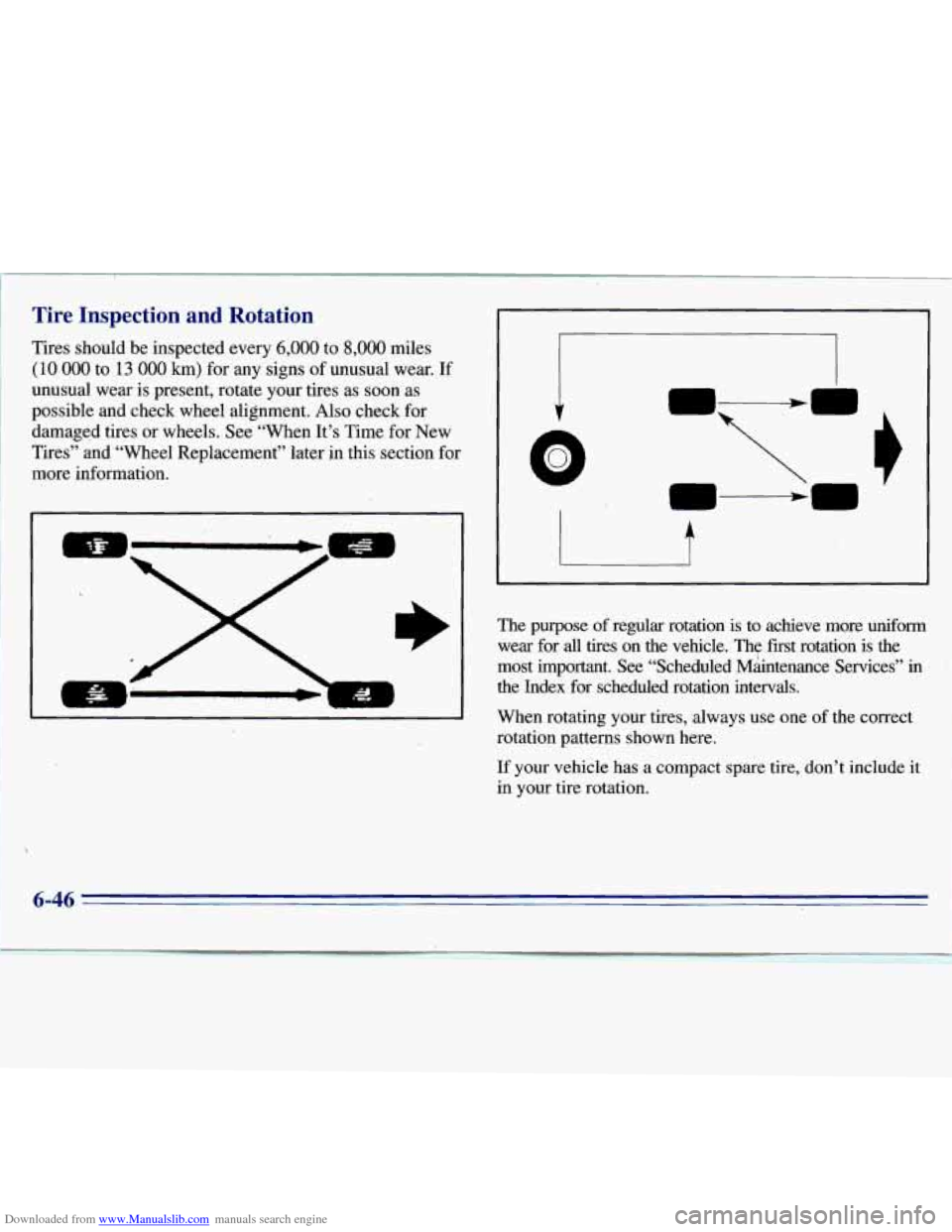
Downloaded from www.Manualslib.com manuals search engine Tire Inspection and Rotation
Fires should be inspected every 6,000 to 8,000 miles
(10 000 to 13 000 km) for any signs of unusual wear. If
unusual wear is present, rotate your tires as
soon as
possible and check wheel alignment. Also check for
damaged tires or wheels. See “When It’s Time for New
Tires” and“‘Whee1 Replacement” later
in this section for
more information.
I
J.
@
I
The purpose of regular rotation is to achieve more uniforrn
wear for all tires on the vehicle. Thy first rotation is the
most important.
See “Scheduled Maintenance Services” in
the Index for scheduled rotation intervals.
When rotating your tires, always use one
of the correct
rotation patterns shown here.
If your vehicle has a compact spare tire, don’t include it
in your tire rotation.
6-46
Page 273 of 375
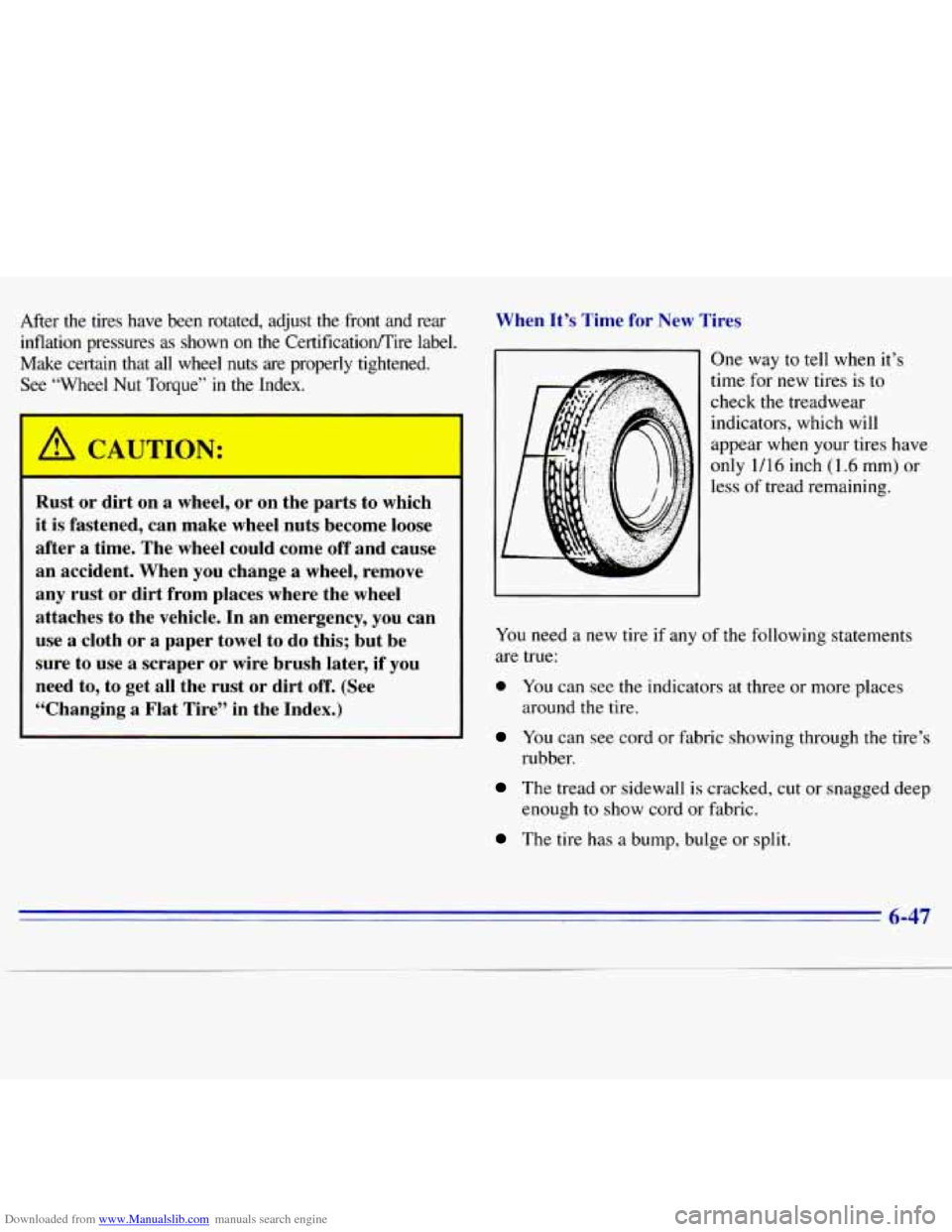
Downloaded from www.Manualslib.com manuals search engine After the tires have been rotated, adjust the front and rear
inflation pressures as shown on the Certificatioflire label.
Make certain that all wheel nuts are properly tightened. See ‘”Wheel Nut Torque” in the Index.
Rust or dirt on a wheel, or on the parts to which
it is fastened, can make wheel nuts become loose
after
a time. The wheel could come off and cause
an accident. When you change
a wheel, remove
any rust or dirt from places where the wheel
attaches to the vehicle. In an emergency, you can
use a cloth or
a paper towel to do this; but be
sure
to use a scraper or wire brush later, if you
need to, to get all the rust or dirt off. (See
“Changing a Flat Tire” in the Index.) When
It’s Time for New Tires
11 One way to tell when it’s
time for new tires is to
check the treadwear
indicators, which will
appear when your tires have
only
1/16 inch (1.6 mm) or
less of tread remaining.
You need a new tire if any of the following statements
are true:
0 You can see the indicators at three or more places
You can see cord or fabric showing through the tire’s
The tread or sidewall is cracked, cut or snagged deep
around
the tire.
rubber.
enough
to show cord or fabric.
The tire has a bump, bulge or dit.
6-47
Page 274 of 375
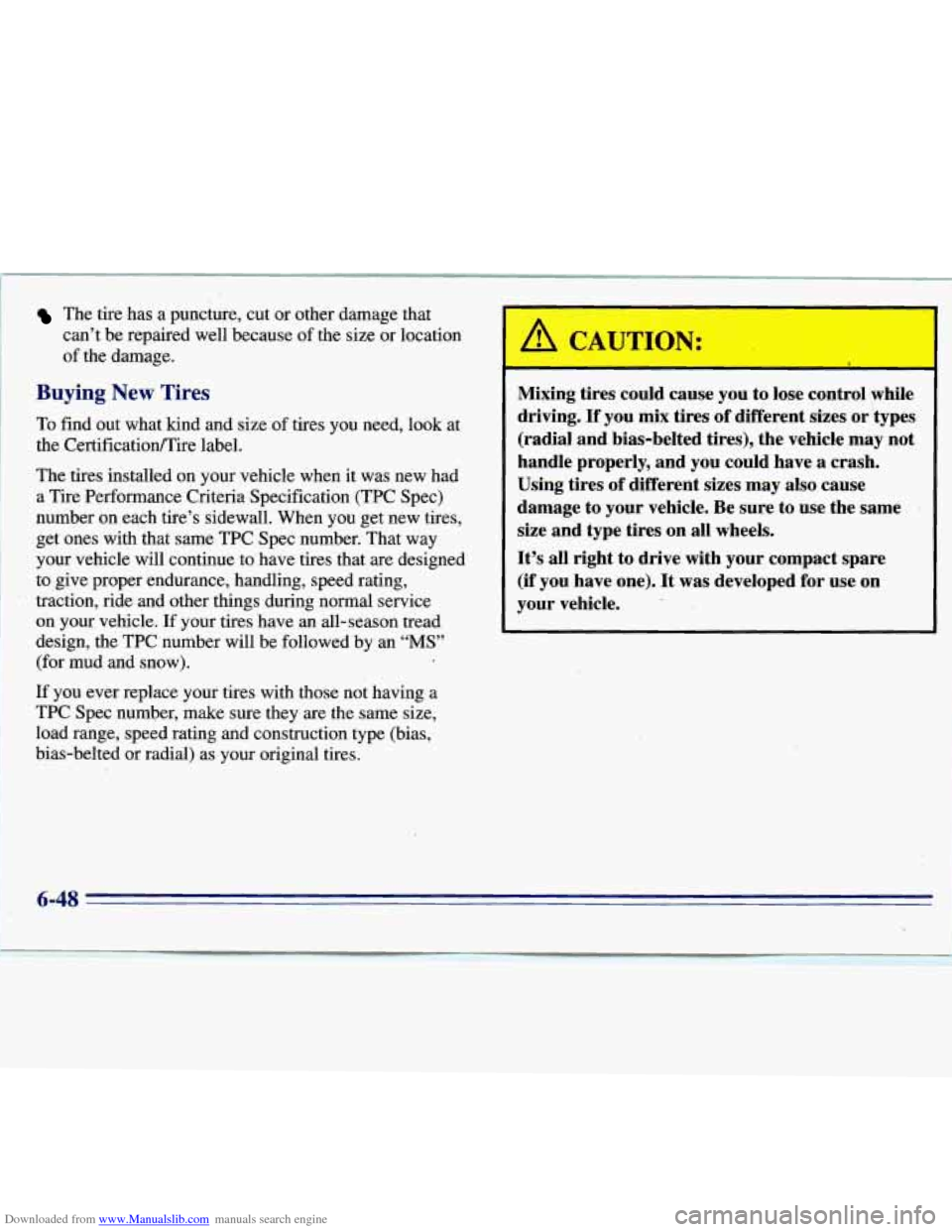
Downloaded from www.Manualslib.com manuals search engine The tire has a panctufe, cut or other .damage that
can’t be repaired well because of the size or location
. of the damage.
Buying New Tires
To find out what kind and size of tires you need, look at
the Certificatioflire label.
The tires installed on your vehicle when it was new had
a Tire Performance Criteria Specification (TPC Spec)
number on each tire’s sidewall. When you get new tires,
get ones with that same TPC Spec number. That way
your vehicle will continue to have tires that are designed
to give proper endurance, handling, speed rating,
traction, ride and other things during normal service
on your vehicle.
If your tires have an all-season tread
design, the TPC number will be followed by an
“MS”
(for mud and snow).
If you ever replace your tires with those not having a
TPC Spec number, make sure they are the same size,
load range, speed rating and construction type (bias,
bias-belted or radial)
as your original tires. Mixing
tires could cause you to lose control while
driving.
If you mix tires of different sizes or ‘types
(radial and bias-belted tires), the vehicle may not
handle properly, and you could have
a crash.
Using tires of different sizes may also cause
damage to your vehicle. Be sure to use the same
size and type tires on all wheels.
It’s all ,right to drive with your compact spare
(if you have one).. It was developed for use on
your vehicle.